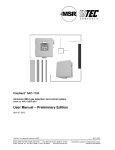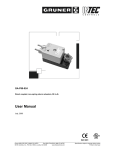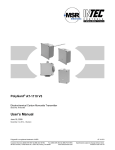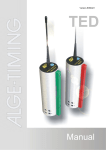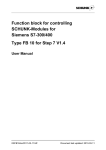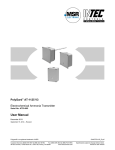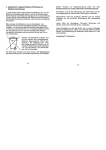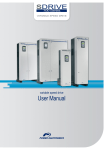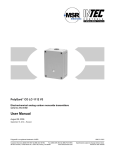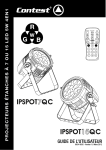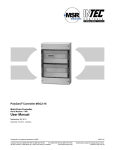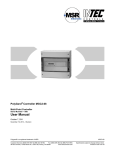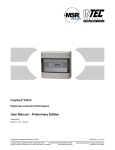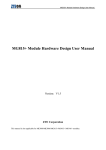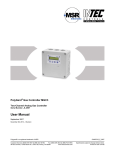Download User Manual - INTEC Controls
Transcript
PolyGard SPC-1130 1CFT Nitrogen dioxide (NO2) gas detection and control system serial no. SPC 1130-001 User Manual November 01, 2003 PolyGard is a registered trademark of MSR Phone (858) 578-7887 & (888) GO INTEC Fax (858) 578-4633 & (888) FX INTEC INTEC Controls, Inc., P.O. Box 12506, La Jolla, CA 92039 www.inteccontrols.com GASPC1130I01 Specification subject to change without notice. Printed in USA 041220 User Manual - PolyGard® NO2 SPC-1130 Page 2 Nitrogen dioxide (NO2) gas detection and control system 1 General Overview ................................................................................................................... 3 2 Description ................................................................................................................................ 3 3 Installation ................................................................................................................................. 5 3.1 3.2 4 Electrical Connection ........................................................................................................... 6 4.1 4.2 5 Set trip/setpoints...................................................................................................................... 8 Set low and high trip/setpoints without optional digital display .............................................. 8 Control trip/setpoint voltage calculation................................................................................ 9 Set low and high trip/setpoints with optional digital display ................................................... 9 Select switching differential of the trip/setpoints....................................................................... 9 Calibration............................................................................................................................... 9 Control span voltage calculation .........................................................................................10 Calibration of digital display range (optional display)...............................................................10 Motherboard jumper selection table........................................................................................11 Displayboard jumper selection table .......................................................................................11 Inspection and Service .......................................................................................................12 6.1 6.2 6.3 7 Instructions.............................................................................................................................. 6 Wiring connection.................................................................................................................... 7 Start-up Operation ................................................................................................................. 8 5.1 5.1.1 5.1.2 5.1.3 5.2 5.3 5.3.1 5.4 5.5 5.6 6 Mounting locations................................................................................................................... 5 Enclosure ................................................................................................................................ 5 Inspection...............................................................................................................................12 Calibration sensor...................................................................................................................12 Replacing sensor element ......................................................................................................12 Troubleshooting.....................................................................................................................13 7.1 Diagnostics.............................................................................................................................13 8 Cross-sensitivity Data ...................................................................................................................14 9 Specifications..........................................................................................................................15 10 Wiring Configuration and Enclosure Dimensions ..............................................17 11 Notes and General Information ....................................................................................22 11.1 11.2 11.3 11.4 11.5 Intended product application ...............................................................................................22 Installers` responsibilities ....................................................................................................22 Maintenance .......................................................................................................................22 Limited warranty .................................................................................................................22 Return instructions ..............................................................................................................22 PolyGard is a registered trademark of MSR Phone (858) 578-7887 & (888) GO INTEC Fax (858) 578-4633 & (888) FX INTEC INTEC Controls, Inc., P.O. Box 12506, La Jolla, CA 92039 www.inteccontrols.com GASPC1130I01 Specification subject to change without notice. Printed in USA 041220 User Manual - PolyGard® NO2 SPC-1130 Page 3 Nitrogen dioxide (NO2) gas detection and control system 1 General Overview The PolyGard NO2 analog single point controller is used for detection of nitrogen dioxide in the ambient air to warn of the presence of nitrogen dioxide gas and to control ventilation systems. 2 Description Gas sensing The sensor portion of the PolyGard NO2 analog single point controller is a micro-fuel cell, which is completely sealed. The measurement is a gas-in-liquid chemical reaction rather than a surface area measurement. With no surface area to coat, this sensor retains its sensitivity to nitrogen dioxide even after prolonged exposure to clean air. The cell consists of a diffusion barrier, O-ring seal, electrolyte reservoir and three electrodes: sensing, counter and reference. The target gas, nitrogen dioxide, enters the cell through a diffusion barrier. The chemical process of the measurement is one of oxidation where one molecule of the target gas is exchanged for one molecule of oxygen. The reaction drives the oxygen molecule to the counter electrode, generating a DC microampere signal between the sensing and counter electrodes. This signal is linear to the volume concentration of the sensed gas rather than the partial pressure. The integrated two-wire transformer converts this DC microampere signal to a standard 4-20 mA signal. In some cases, biasing is required to maintain a voltage differential between the reference and sensing electrode in order to facilitate the necessary reaction in the cell. The transmitter electronics will provide the necessary bias voltage when configured for one of these sensor types. Most sensors produce a small amount of baseline current in clean air. This is adjusted out with the zero potentiometer on the transmitter. This oxidation at the electrodes causes wear of the sensor. Typical life for this sensor is approximately two years in normal operation. This will vary somewhat from sensor to sensor, with some working lifetimes less than two years and some greater than 2 years. This wear also changes the characteristics of the sensor, requiring periodic recalibration. It is recommended that the sensor accuracy be verified every six months and recalibrated as necessary. Relay output The controller output provides two (2) adjustable trip/setpoints within the sensing range. If the NO2 concentration exceeds any trip/setpoint value the respective alarms will be activated. The low or high alarm trip/setpoint level correspond to the relay outputs 1K1 (R1) and 1K2 (R2). The output relay R3 can be assigned to either low alarm or high alarm. The controller has a self-diagnostic to detect any power supply voltage or sensor failures. When a failure occurs it triggers relay output R4. The fail-safe relay R4 will close in case of loss of supply voltage or sensor failure. Analog output The 4-20 mA output is linear and represents the range of 0-10 ppm actual sensor proportional value. This signal can be used with any external DDC/PLC control or automation system. Test button With this button pushed, it simulates the maximum gas concentration. Low and high alarms will be activated and the display will show the maximum value. PolyGard is a registered trademark of MSR Phone (858) 578-7887 & (888) GO INTEC Fax (858) 578-4633 & (888) FX INTEC INTEC Controls, Inc., P.O. Box 12506, La Jolla, CA 92039 www.inteccontrols.com GASPC1130I01 Specification subject to change without notice. Printed in USA 041220 User Manual - PolyGard® NO2 SPC-1130 Page 4 Manual override of low alarm relay Manual switch for “Auto” or “On” function of the relay 1K1 (R1) Switch position: Auto = alarm relay 1K1 normal operation On = alarm relay 1K1 manually on Caution! Replacement sensor elements, which are not bias types, are shipped with a tiny spring of wire shorting the sensor and reference electrodes. This spring MUST BE REMOVED prior to installing the element into the sensor assembly. Optional Display 3.5 digits display of concentration LED power: green red Power on, and normal operation Failure operation LED alarm: orange red Low alarm level active Low and high alarm level active Button “Reset 2nd Alarm” Reset high alarm, when relay is set to latched Button “Reset Audible” Reset internal horn and relay R3 for remote alarm Optional time delay relay for low alarm Time delay relay for delayed activation of relay 1K1 RTE-P11 analog timer = on-delay, adjustable from 0.1 min to 10 min PolyGard is a registered trademark of MSR Phone (858) 578-7887 & (888) GO INTEC Fax (858) 578-4633 & (888) FX INTEC INTEC Controls, Inc., P.O. Box 12506, La Jolla, CA 92039 www.inteccontrols.com GASPC1130I01 Specification subject to change without notice. Printed in USA 041220 User Manual - PolyGard® NO2 SPC-1130 Page 5 3 Installation Note: • Avoid any force (e.g. by thumb) during operation or installation on the sensor element. This could destroy the element. Electronics can be destroyed through static electricity. Therefore, do not work on the equipment without a wrist strap connected to earth ground or standing on conductive floor. • 3.1 Mounting locations • • • The specific weight of nitrogen dioxide is heavier than that of air (factor 1.59). Location of the SPC 1130 must conform to the layout of the area being monitored. Disregard the ventilation ratio! Do not mount SPC 1130 in the center of the airflow. In larger rooms, it might be necessary to install two or more SPC 1130 where there is not adequate air movement. Do not mount in corners or directly in front of air inlets (e.g. doors, windows, open ramps, dampers, etc.). In areas with undefined air movement, it might be necessary to distribute several SPC 1130 in a vertical and horizontal direction over the whole area to be monitored. Avoid locations where water, oil etc. may influence proper operation and where mechanical damage might be possible. Mounting height is one foot (0.3 m) above floor. Provide adequate space around SPC 1130 for maintenance and calibration work. • • • 3.2 Enclosure • • • • The door of the enclosure is lockable with supplied key (5/16 in. (8 mm) triangle key). Use the provided template for locating position of wall mounting holes. Screw the enclosure vertically on wall. (see Fig. 2, page 18). When wiring is completed, put back the wire track cover and close the door of the enclosure. (see Fig. 1, page 17). PolyGard is a registered trademark of MSR Phone (858) 578-7887 & (888) GO INTEC Fax (858) 578-4633 & (888) FX INTEC INTEC Controls, Inc., P.O. Box 12506, La Jolla, CA 92039 www.inteccontrols.com GASPC1130I01 Specification subject to change without notice. Printed in USA 041220 User Manual - PolyGard® NO2 SPC-1130 Page 6 4 Electrical Connection 4.1 Instructions Note: Electrostatic discharge (ESD) may damage electronic components. During wiring, open the cover only when completely grounded via grounding strap or standing on conductive floor. • • Connections should be made without any power applied to conductors. Installation of the electrical wiring should be according to the connection diagram and only performed by a trained specialist. For the 4-20 mA analog output signal use shielded cable to avoid any influence from external interference. Recommended cable: 18 AWG shielded, maximum resistance 20.8 Ω/1000 ft (73 Ω/1000 m) Cable for power and relay outputs do not need to be shielded. • • • Power terminal block X1 Connector H Connector N Connector G 120 VAC 50/60Hz (24V AC/DC without transformer) 0 VAC/DC Earth ground Motherboard terminal strip X2 Connector 1 Connector 2 Connector 3 Connector 4 Connector 5 Connector 4-20 mA sensor output signal (common)* 4-20 mA sensor output signal (positive) Power supply 24 VAC 0 VAC/DC Power supply 24 VDC (19 - 28 VDC) * Note: When the SPC analog output signal is connected to an external controller, the controller’s analog input must provide isolation for the 4-20 mA signal. If the 4-20 mA signal is used, then remove Jumper JP1 located on the motherboard. Motherboard terminal strip X3 (relay output without optional time delay relay 1K1): Connector 1-2 Connector 3 Connector 4 Connector 5 R1, low alarm relay activates the 1K1 relay via internal wiring NO NC R2, high alarm relay activates the 1K2 relay via internal wiring COM Connector 6-7 Connector 8-9 R3, potential free contact for remote alarming R4, potential free contact for remote fail-safe alarming Low alarm relay socket 1K1 (DPDT) Contact set 1 of DPDT Connector 5 Connector 1 Connector 9 Contact set 2 of DPDT Connector 8 NO Connector 4 NC Connector 12 COM PolyGard is a registered trademark of MSR Phone (858) 578-7887 & (888) GO INTEC Fax (858) 578-4633 & (888) FX INTEC INTEC Controls, Inc., P.O. Box 12506, La Jolla, CA 92039 www.inteccontrols.com GASPC1130I01 Specification subject to change without notice. Printed in USA 041220 User Manual - PolyGard® NO2 SPC-1130 Page 7 High alarm relay socket 1K2 (DPDT) Contact set 1 of DPDT Connector 5 Connector 1 Connector 9 Contact set 2 of DPDT Connector 8 NO Connector 4 NC Connector 12 COM Optional low alarm time delay relay socket 1K1 (DPDT) Contact set 1 of DPDT Connector 6 Connector 5 Connector 8 Contact set 2 of DPDT Connector 3 NO Connector 4 NC Connector 1 COM 4.2 Wiring connection Static electricity (see section 4.1). • • Open the door of the enclosure. Pull cables via the conduit openings into the enclosure, and connect cable leads to the appropriate terminal connectors. PolyGard is a registered trademark of MSR Phone (858) 578-7887 & (888) GO INTEC Fax (858) 578-4633 & (888) FX INTEC INTEC Controls, Inc., P.O. Box 12506, La Jolla, CA 92039 www.inteccontrols.com GASPC1130I01 Specification subject to change without notice. Printed in USA 041220 User Manual - PolyGard® NO2 SPC-1130 Page 8 5 Start-up Operation Only trained technicians should perform the following: • • • • Check mounting location. Check power voltage. Check for correct sensor element (7 NDH) at sensorboard terminal X3 PCB EC-C. Check and/or select the appropriate jumpers for remote alarm function, relay R3. (see section 5.5, motherboard jumper selection table). Check and/or select the appropriate jumper for failure function, relay R2. (see section 5.5, motherboard jumper selection table). Check and/or select the appropriate jumper for latched function, relay R2. (see section 5.5, motherboard jumper selection table). Check and/or adjust trip/setpoints for low and high alarm levels. (see section 5.1, motherboard potentiometers R31and R32). Check and/or put switch into “Auto” position, manual override of low alarm. Verify sensor/transmitter operation by mearsuring approximately 200 mV (about 0 ppm NO2) on sensorboard terminal -X6 and +X6. • • • • • Required instruments to start-up and calibrate the SPC: • • • • • • Test gas bottle with synthetic air. Test gas bottle with 5 ppm NO2. Gas pressure regulator with flow meter to control the gas flow at 300 ml/min. Sensor head calibration adapter with tubing. Digital voltmeter with a range of 0-2 VDC and 0-10 VDC, accuracy 1%. Small screwdriver. Note: Please observe proper handling procedures for test gas bottles! 5.1 Set trip/setpoints 5.1.1 Set low and high trip/setpoints without optional digital display Set low trip/setpoint • Connect a digital voltmeter to test jacks J1 (red) and JM (black) on the motherboard with a range selected that will display 10 VDC maximum. Adjust the low trip/setpoint voltage, with potentiometer ”R31” at the motherboard, until the signal reads the appropriate mVDC ± 2 mV (see section 5.1.2, calculation for trip/setpoint control voltage). • Set high trip/setpoint • Connect a digital voltmeter to test jacks J2 (red) and JM (black) on the motherboard with a range selected that will display 10 VDC maximum. Adjust the high trip/setpoint with potentiometer ”R32” at the motherboard until the signal reads the appropriate mVDC ± 2 mV (see section 5.1.2, calculation for trip/setpoint control voltage). • PolyGard is a registered trademark of MSR Phone (858) 578-7887 & (888) GO INTEC Fax (858) 578-4633 & (888) FX INTEC INTEC Controls, Inc., P.O. Box 12506, La Jolla, CA 92039 www.inteccontrols.com GASPC1130I01 Specification subject to change without notice. Printed in USA 041220 User Manual - PolyGard® NO2 SPC-1130 Page 9 5.1.2 Control trip/setpoint voltage calculation = 0.48 V x trip/setpoint (ppm) + 1.20 VDC (ppm) Example Trip/setpoint value Control voltage 2 ppm 2.16 V 0.48 (V) x 2 (ppm) + 1.20 (V) = 2.16 V (ppm) 5.1.3 Set low and high trip/setpoints with optional digital display • Set display jumper on displayboard into position “JP1” to “JP 1.2”. This will provide a display value with +/sign. Set low trip/setpoint • Set mode-operating switch “S1” on displayboard into position 1 (far left position). The digital display indicates the low trip/setpoint value. • Adjust the low trip/setpoint with potentiometer “R31” on the motherboard. The trip/setpoint value can be read on the digital display. Set high trip/setpoint • Set mode-operating switch “S1” on displayboard into position 2 (second position from the left). The digital display indicates the high trip/setpoint value. • Adjust the high trip/setpont with potentiometer “R32” on the motherboard. The trip/setpoint value can be read on the digital display. • Set mode-operating switch “S1” on displayboard into position 4 (far right position). This is the normal operating mode (see Fig. 5, page 18). • Set display jumper on displayboard back into position “JP1” to “JP1.1”. This provides a display value without any +/- sign. 5.2 Select switching differential of the trip/setpoints Individual switching differentials can be selected per trip/setpoint via jumpers “JP6” and “JP8” on the motherboard, either 4% or 10% differential of full transmitter range (see section 5.5, motherboard jumper selection table). For example, with factory standard range 0-10 ppm NO2, 4% differential = 0.4 ppm, and 10% differential = 1.0 ppm. 5.3 Calibration Note: If calibration is necessary, the sensor element must be powered and be fully stabilized for at least 4 hour. Zero adjustment Zero-point calibration (4 mA): (After sensor warm-up) • Connect digital voltmeter to test pins - and + at sensorboard (with a range selected that will display 2 VDC max.). • Connect the calibration adapter to sensor element. • Apply sensor element zero calibration gas, (300 ml/min; 14.5 psi ± 10%), or other clean air source. • Wait two minutes until the signal is stable; adjust signal with zero potentiometer ”Zero” until the signal is 200 mV ± 2 mV and stable (sensorboard). • Remove calibration adapter carefully by turning lightly. PolyGard is a registered trademark of MSR Phone (858) 578-7887 & (888) GO INTEC Fax (858) 578-4633 & (888) FX INTEC INTEC Controls, Inc., P.O. Box 12506, La Jolla, CA 92039 www.inteccontrols.com GASPC1130I01 Specification subject to change without notice. Printed in USA 041220 User Manual - PolyGard® NO2 SPC-1130 Page 10 Span adjustment Note: NO2 calibration gas is toxic; never inhale the gas! Symptoms: Dizziness, headache and nausea. Procedure if exposed: Bring into fresh air at once, consult doctor. • • • Connect calibration adapter to the sensor element. Apply sensor element span calibration gas (5 ppm NO2), (300 ml/min; 14.5 psi ± 10%). Wait two minutes until the signal is stable, adjust signal with span potentiometer ”Span” until the signal reads the appropriate mVDC (± 3 mV, see calculation for control voltage 5.3.1) and is stable (sensorboard). Remove calibration adapter with a careful light turn. Inspect the seating of the sensor element! • 5.3.1 Control span voltage calculation 800 (mV) x test gas concentration (ppm) Sensing range NO2 (ppm) + 200 (mV) Example Sensing range NO2 concentration Test gas concentration Control voltage 10 ppm 5 ppm 600 mV 800 (mV) x 5 (ppm) + 200 (mV) = 600 mV 10 (ppm) 5.4 Calibration of digital display range (optional display) Note: The display range is factory set and normally does not require any field adjustment. Adjustment can only be made when the sensorboard test pins “X6+” and “X6-“ read 200 mV. This represents a 0 ppm NO2 value. Calibrate maximum display range of 10 ppm NO2 • Connect digital voltmeter to test pins “J3+” and “J4-“ on the displayboard with a range selected that will display 300 mVDC maximum. Adjust the maximum display range voltage with potentiometer “R31” on the displayboard until the signal reads 193 mVDC ± 1 mVDC. • Calibrate zero point display of 0 ppm NO2 • Adjust the zero point with potentiometer “R32” on the displayboard until the digital display reads 0 ppm. PolyGard is a registered trademark of MSR Phone (858) 578-7887 & (888) GO INTEC Fax (858) 578-4633 & (888) FX INTEC INTEC Controls, Inc., P.O. Box 12506, La Jolla, CA 92039 www.inteccontrols.com GASPC1130I01 Specification subject to change without notice. Printed in USA 041220 User Manual - PolyGard® NO2 SPC-1130 Page 11 5.5 Motherboard jumper selection table Element Function 4-20 mA signal for external use X 4-20 mA not used Factory Set Jumper JP1 X Relay R3 will be active with low alarm X*1 Jumper JP3 Relay R3 will be active with high alarm X* 1 Jumper JP4 Relay R3 will be not active X* 1 Jumper JP5 System failure also activates high alarm System failure does not activate high alarm X X High alarm without latch function 1-2 High alarm with latch function 2-3 With optional digital display X Without optional digital display X Switching differential of low trip/setpoint, 4% 1-2 Switching differential of low trip/setpoint, 10% 2-3 Switching differential of high trip/setpoint, 4% 1-2 Switching differential of high trip/setpoint, 10% 2-3 Jumper JP9 Jumper JP12 Jumper JP2 Jumper JP6 Jumper JP8 Internal function X Jumper JP7*2 Internal function 2-3 Jumper JP10*2 Internal function 1-2 Jumper JP11*2 Note: *1 Only one of the three jumpers can be installed. *2 Do not change the factory jumper position setting. 5.6 Displayboard jumper selection table Element Function Display value without sign +/- X Jumper JP1.1 Display value with sign +/- X Jumper JP1.2 Button “Reset 2 (high) alarm” enabled X Button “Reset 2 (high) alarm” disabled Internal function 1 X X Factory Set Jumper JP12 Jumper JP71 Do not change the factory jumper position setting PolyGard is a registered trademark of MSR Phone (858) 578-7887 & (888) GO INTEC Fax (858) 578-4633 & (888) FX INTEC INTEC Controls, Inc., P.O. Box 12506, La Jolla, CA 92039 www.inteccontrols.com GASPC1130I01 Specification subject to change without notice. Printed in USA 041220 User Manual - PolyGard® NO2 SPC-1130 Page 12 6 Inspection and Service 6.1 Inspection Inspection and service of the single point controller should be done by a trained technician and executed on a periodic interval. It is recommended that the sensor operation be verified at least every six months. 6.2 Calibration sensor (See part 5.3) • Service at periodic intervals is to be decided by the person responsible for the gas detection system. • If span calibration voltage of 600 mV (see note below) is no longer attainable when applying 5 ppm nitrogen dioxide in air, then the sensor element has to be replaced. After the sensor element has been replaced, a calibration is required. Note: If using a different level of span test gas ppm, or different sensor range, then the mV needs to be calculated. 6.3 Replacing sensor element Static electricity ( see section 4.1). Sensor should always be installed without power applied, remove fuse “1F1”. • Unplug old sensor element out from the sensorboard. • Take new sensor element out of original packing and remove the shorting wire on the sensor element contacts. • Plug sensor element in the connector X3 at the sensorboard. • After sensor warm-up, turn potentiometer “Span”, located on sensorboard, to its center position. (Turn the pot 25 rotations counter-clockwise, then 11 rotations clockwise to be centered.) • Calibrate (see section 5.3). PolyGard is a registered trademark of MSR Phone (858) 578-7887 & (888) GO INTEC Fax (858) 578-4633 & (888) FX INTEC INTEC Controls, Inc., P.O. Box 12506, La Jolla, CA 92039 www.inteccontrols.com GASPC1130I01 Specification subject to change without notice. Printed in USA 041220 User Manual - PolyGard® NO2 SPC-1130 Page 13 7 Troubleshooting 7.1 Diagnostics Trouble Reason Solution No indication of power (opional with display), Power not applied Measure power on terminal block X1 terminal H / N for 120 VAC (24 Check miniature fuses 1F1, 1F2 or F1 on motherboard Check cable connections for tight fit and/or test button does not function No indication value at digital display Fuse failure Interruption in the cable connection between motherboard and displayboard Failure on displayboard Replace displayboard Mode operating switch S1 on displayboard, position 3 = OFF Set switch in position: 1 = low trip/setpoint 2 = high trip/setpoint 4 = sensed value Interruption in the cable Check cable connections for tight fit connection between motherboard and displayboard Failure on displayboard Replace displayboard Cannot calibrate sensorboard Interruption in the cable Check cable connections for tight fit connection between motherboard and displayboard Sensor sensitivity too low Replace sensor Failure on sensorboard Replace sensorboard Cannot set trip/setpoints Trip/setpoint values are set too high Failure on motherboard Adjust trip/setpoint values again (see section 5.1 to 5.3) Replace motherboard Fail-safe alarm Check cable connection, or if necessary replace and calibrate sensor Recalibrate the sensor, or if necessary replace sensor element Interruption of sensor cable or sensor sensitivity too low Control span voltage lower then 200mV PolyGard is a registered trademark of MSR Phone (858) 578-7887 & (888) GO INTEC Fax (858) 578-4633 & (888) FX INTEC INTEC Controls, Inc., P.O. Box 12506, La Jolla, CA 92039 www.inteccontrols.com GASPC1130I01 Specification subject to change without notice. Printed in USA 041220 User Manual - PolyGard® NO2 SPC-1130 Page 14 8 Cross-sensitivity Data This table shows the typical response to be expected from the sensor when exposed to the following gases. Gas Chemical mark Gas concentration Carbon monoxide CO 300 ppm 0 ppm Chlorine CL2 1 ppm ~ 1 ppm Ethylene C 2H4 100 ppm 0 ppm Hydrogen H2 100 ppm 0 ppm Hydrogen chloride HCI 5 ppm 0 ppm Hydrogen cyanide HCN 10 ppm 0 ppm Hydrogen sulphide H2 S 15 ppm - 1.5 ppm Nitric oxide NO 35 ppm ≤ 7 ppm Sulphur dioxide SO2 5 ppm 0.05 ppm PolyGard is a registered trademark of MSR Phone (858) 578-7887 & (888) GO INTEC Fax (858) 578-4633 & (888) FX INTEC INTEC Controls, Inc., P.O. Box 12506, La Jolla, CA 92039 www.inteccontrols.com Tolerance ppm NO2 GASPC1130I01 Specification subject to change without notice. Printed in USA 041220 User Manual - PolyGard® NO2 SPC-1130 Page 15 9 Specifications Electrical Power supply: Power consumption: - w/optional heater RFI/EMI protection Sensor Performance Gas detected Sensor element Range Stability & resolution Repeatability Long term output drift Response time Sensor life expectancy Sensor coverage Installation Location Mounting height Relay outputs Low alarm (1K1) High alarm (1K2) Remote alarm (R3) Fail-safe (R4) Type of Control General Trip/setpoints - Low alarm - High alarm Switching differential Analog output signal Audible alarm Visual Indications and Reset Push Buttons, optional Digital display Power/operating status LED Alarm status LED Reset 2nd alarm button Reset audible button Alarm acknowledgement / reset function 120 VAC, -10%/ +20%, 50/60 Hz, or 24 VAC/DC, -10%/ +20%, without built-in transformer resettable 1.6 A fuse 0.6 A (15 VA), max. 1.6 A (39 VA), max. 5.0 W @ 1ft. (0.31 m) radiated Nitrogen dioxide (NO2) Electrochemical, diffusion 0 - 10 ppm factory set 0 - 10 to 0 - 20 ppm, adjustable via calibration ± 0.1 ppm of reading 2% of reading < 2% signal loss/month t90 ≤ 40 sec. 2 years, normal operating environment 4,000 sq.ft. (372 m2) to 6,000 sq.ft. (558 m2) under “ideal conditions” 1 ft. (0.3 m) above floor DPDT, 10 A (optional time delay relay, 10 A) potential free, 250 VAC DPDT, 10 A, potential free, 250 VAC max. SPST, 5 A, potential free, 250 VAC max. SPST, 5 A, potential free, 250 VAC max. Two-stage, low and high alarm Trip/setpoints 2 ppm NO2 (factory calibrated, user adjustable) 5 ppm NO2 (factory calibrated, user adjustable) 4 % or 10% of sensing range, selectable 4-20 mA for external controller (the controller’s analog input must provide isolation for the 4-20 mA signal), load > 50 kOhm 90 dB, enabled or disabled, selectable 3.5 digit, ppm reading Green = power on / Red = failure Orange = low alarm / Red = high alarm LED on = w/high alarm on (only w/latched relay configuration) LED on = w/internal horn and/or relay R3 for remote alarm is on Low alarm: auto reset High alarm: auto reset or manual reset, selectable PolyGard is a registered trademark of MSR Phone (858) 578-7887 & (888) GO INTEC Fax (858) 578-4633 & (888) FX INTEC INTEC Controls, Inc., P.O. Box 12506, La Jolla, CA 92039 www.inteccontrols.com GASPC1130I01 Specification subject to change without notice. Printed in USA 041220 User Manual - PolyGard® NO2 SPC-1130 Operating Environment Working temperature Storage temperature Humidity Pressure range Optional Heater, built-in Ambient temperature Thermostatic control Physical Characteristics Enclosure material Enclosure color Protection Installation Dimensions, enclosure (HxWxD) Dimensions, splash guard (HxDia.) Cable entry Wire connection Wire size Weight Approvals/Listings - unit - relays - transformer Warranty Page 16 23 °F to 104 °F (-5 °C to + 40 °C) 23 °F to 86 °F (-5 °C to + 30 °C) 15 to 95% RH non-condensing Atmospheric ±10% For low temperature environment -22 °F to 104 °F (-30 °C to 40 °C) 32 °F (0 °C) ± 5 °F (3 °C) Steel case Light beige NEMA 4 (IP 55) Wall (surface) mounted 9.06 x 8.27 x 5.6 in. (230 x 210 x 142 mm) 0.63 x 2.56 in. (16 x 65 mm) 3 holes for ½ in. conduit, covered Terminal blocks, screw type for lead wire Min. 24 AWG (0.25 mm2) max. 14 AWG (2.5 mm2) 8.8 Ibs. (4.0 kg) City of Los Angeles approval* CE EMV-compliance 89/336/EWG UL-recognized, CSA-certified, TÜV UL-listed, CSA-certified Two years material and workmanship * = Pending PolyGard is a registered trademark of MSR Phone (858) 578-7887 & (888) GO INTEC Fax (858) 578-4633 & (888) FX INTEC INTEC Controls, Inc., P.O. Box 12506, La Jolla, CA 92039 www.inteccontrols.com GASPC1130I01 Specification subject to change without notice. Printed in USA 041220 User Manual - PolyGard® NO2 SPC-1130 Page 17 10 Wiring Configuration and Enclosure Dimensions Wiring Configuration Fig. 1 “CFT” version (relays 1K1 & 1K2 not included), contact positions for R1 low alarm, R2 high alarm, R3 remote strobe/horn alarm and R4 fail-safe 1 NC NO 5 12 Common 4 NC 8 NO 9 Common 1 NC 5 NO 12 Common 4 NC 8 NO 7 NO 6 Common NO NC NO NC Low alarm level standard DPDT relay "1K1 (R1)" NO NC NO NC Low Alarm Standard Relay 1K1 (R1) C High Alarm Standard Relay 1K2 (R2) C 1F1 FUSE 1F2 FUSE 4-20 mA C H N G Power Terminal Block X1 High alarm level standard DPDT relay "1K2 (R2)" C 1.6 A replaceable fuse is installed per fuse holder Common coil coil 9 – Power on and alarm condition • R1, contacts 1-2 closed • R2, contacts 3-5 open, 4-5 closed • R3, contacts 6-7 closed • R4, contacts 8-9 open – Power loss or system failure • R4, contacts 8-9 closed coil coil – Power off, as drawn – Power on and no alarm condition • R1, contacts 1-2 open • R2, contacts 3-5 closed, 4-5 open • R3, contacts 6-7 open • R4, contacts 8-9 open * Wire Track Transformer 1T1 24 24 VAC VDC R1 R2 R3 R4 (–) (+) (+) (–) (+) X1 Remote strobe/horn/ display alarm actuation "R3" X2 1 2 3 4 5 1 X3 2 3 4 5 6 7 8 9 Motherboard X1 = Ribbon cable connection to transmitter and display (factory installed) X3 9 NC 8 Common Remote fail-safe "R4" Power terminal block "X1" X3 G Ground shield 2 (Signal) 1 (Common) Gray Blue Green/yellow H N G 4-20 mA analog output signal to remote controller or BAS Note: 4-20 mA signal is internally powered. DO NOT supply power to 4-20 mA signal or common. X2 Relay contact positions 1K1 (R1), 1K2 (R2), R3 and R4: – Power off, as drawn – Power on and no alarm condition, as drawn, and R4 is open – Power on and alarm condition for 1K1 (R1), 1K2 (R2) and R3, contacts are closed between common and NO, and R4 stays open – Power loss or system failure, R4 is closed AC hot AC neutral Earth ground 120 VAC or 24 VAC/DC power supply * With 24 VAC/DC power supply: – Remove factory installed transformer "1T1" and transformer wires – Disconnect lead wire from " 1F2" fuse block terminal and connect to "1F1 *(right hand)" fuse block terminal 1F1 FUSE 1F2 FUSE * – Add wire and connect between AC neutral "N (leftside)" of power terminal block and "X2 - terminal 4" of motherboard (–) Recommended Twisted, shielded wire for 4-20 mA output signal Grounded housing PolyGard is a registered trademark of MSR Phone (858) 578-7887 & (888) GO INTEC Fax (858) 578-4633 & (888) FX INTEC INTEC Controls, Inc., P.O. Box 12506, La Jolla, CA 92039 www.inteccontrols.com X2 4 Power Terminal Block X1 H N G GASPC1130I01 Specification subject to change without notice. Printed in USA 041220 User Manual - PolyGard® NO2 SPC-1130 Page 18 Assembly Fig. 2 8.27 in. (210 mm) NC NO NC High Alarm Standard Relay 1K2 (R2) C H N G Fuse (1,6 A) 1F1 Fuse (1,6 A) 1F2 4-20 24 24 mA VAC VDC 1T1 Transformer 4011MWSH * R1 F1 800mA (-) (+) (~) (-) (+) R2 R3 R4 X3 1 2 3 4 5 1 2 3 4 5 6 7 8 9 JP1 R1 R2 R3 Low alarm override R4 JP5 JP4 JP3 JP2 JP11 1 JP6 S1 J2 J1 JM 1 1 JP8 JP10 1 Motherboard 23050167 JP9 R31 JP12 S1 AUTO JP7 X1 X2 ON Mounting hole d = 0.2 in. (5 mm) Power Terminal Block X1 C 9.06 in. (230 mm) NO C 5.90 in. (150 mm) NC C Mounting hole d = 0.2 in. (5 mm) NO Low Alarm Standard Relay 1K1 (R1) Wire Track NC COIL COIL NO COIL COIL 6.70 in. (170 mm) R32 1 Horn 0.40 in. (10 mm) PolyGard is a registered trademark of MSR Phone (858) 578-7887 & (888) GO INTEC Fax (858) 578-4633 & (888) FX INTEC INTEC Controls, Inc., P.O. Box 12506, La Jolla, CA 92039 www.inteccontrols.com GASPC1130I01 Specification subject to change without notice. Printed in USA 041220 User Manual - PolyGard® NO2 SPC-1130 Page 19 Dimensions Fig. 3 8.27 in. (210 mm) 0.63 in. (16 mm) MSR / PolyGard / 9.06 in. (230 mm) 0 8.0 green = Power red = Trouble Pow er Reset 2. Alarm Alarm ppm orange= 1.Alarm red = 2. Alarm Reset Audible 5.6 in. (142 mm) 0.63 in. (16 mm) PolyGard is a registered trademark of MSR Phone (858) 578-7887 & (888) GO INTEC Fax (858) 578-4633 & (888) FX INTEC INTEC Controls, Inc., P.O. Box 12506, La Jolla, CA 92039 www.inteccontrols.com GASPC1130I01 Specification subject to change without notice. Printed in USA 041220 User Manual - PolyGard® NO2 SPC-1130 Page 20 Motherboard Fig. 4 R1 F1 800mA (-) (+) (~) (-) (+) R2 R3 R4 JP7 X2 X1 Connector dispaly and sensorboard 4-20 24 24 mA VAC VDC JP1 X3 1 2 3 4 5 Analog output w/without display JP2 R3 = not active R3 = w/High alarm active R3 = w/Low alarm active 1 2 3 4 5 6 7 8 9 R1 R2 R3 R4 JP5 JP4 JP3 J1 JP11 1 JP6 S1 Motherboard 23050167 J2 JM 1 1 JP8 JP10 1 JP9 R31 JP12 Testpin JM (Common) Testpin J2 High trip/setpoint value Testpin J1 Low trip/setpoint value Switching differential of High trip/setpoint value R32 Adjustment trip/setpoint High trip/setpoint 1 Test button Switching differential of Low trip/setpoint value System failure actives high alarm High alarm latch Adjustment trip/setpoint Low trip/setpoint Displayboard Fig. 5 R31 R32 J3 J4 S1 1 2 3 4 Mode operating switch 1 = set trip/setpoint Low 2 = set trip/setpoint High 3 = NC 4 = Normally operating mode Adjusted max. value Adjusted min. value Testpin display range JP7 JP12 Changing display range X1 Connector dispaly and sensorboard JP1.2 JP1.1 Display w/without sign Button “Reset Alarm High” activates ANZEXST.CDR Displayboard 2305001 PolyGard is a registered trademark of MSR Phone (858) 578-7887 & (888) GO INTEC Fax (858) 578-4633 & (888) FX INTEC INTEC Controls, Inc., P.O. Box 12506, La Jolla, CA 92039 www.inteccontrols.com GASPC1130I01 Specification subject to change without notice. Printed in USA 041220 User Manual - PolyGard® NO2 SPC-1130 Page 21 + EC-C 003 230398 X6 X9 X2 1 Sensorboard Fig. 6 C S X3 R Sensor VR3 Span VR2 Zero Platin310 PolyGard is a registered trademark of MSR Phone (858) 578-7887 & (888) GO INTEC Fax (858) 578-4633 & (888) FX INTEC INTEC Controls, Inc., P.O. Box 12506, La Jolla, CA 92039 www.inteccontrols.com GASPC1130I01 Specification subject to change without notice. Printed in USA 041220 User Manual - PolyGard® NO2 SPC-1130 Page 22 11 Notes and General Information It is important to read this user manual thoroughly and clearly understand the information and instructions. The PolyGard® single point controller must be used within product specification capabilities. The appropriate operating and maintenance instructions and recommendations must be followed. Due to ongoing product development, MSR reserves the right to change specifications without notice. The information contained herein is based upon data considered to be accurate. However, no guarantee is expressed or implied regarding the accuracy of this data. 11.1 Intended product application The PolyGard® NO2 SPC-1130 single point controller is designed and manufactured for control applications for energy savings and OSHA air quality compliance in commercial buildings and manufacturing plants (i.e., detection and automatic exhaust fan control for automotive maintenance facilities, enclosed parking garages, engine repair shops, warehouses with forklifts, fire stations, tunnels, etc.). 11.2 Installers` responsibilities It is the installer`s responsibility to ensure that all PolyGard® single point controller is installed in compliance with all national and local codes and OSHA requirements. Installation should be implemented only by individuals familiar with proper installation techniques and with codes, standards and proper safety procedures for control installations and the latest edition of the National Electrical Code (ANSI/NFPA70). It is also essential to strictly follow all instructions as provided in the user manual. 11.3 Maintenance It is recommended that the PolyGard® single point controller performance check be done on a routine schedule. Any performance deviations may be serviced based on needed requirements. Re-calibration and part replacement may be implemented in the field by a qualified individual and with the appropriate tools. Alternatively, the easily removable plug-in transmitter card with the sensor may be returned for service to INTEC Controls. 11.4 Limited warranty MSR and INTEC Controls warrant the PolyGard® single point controller for a period of two (2) years from the date of shipment against defects in material or workmanship. Should any evidence of defects in material or workmanship occur during the warranty period, MSR or INTEC Controls will repair or replace the product at their own discretion, without charge. This warranty does not apply to units that have been altered, had repair attempted, or been subjected to abuse, accidental or otherwise. The warranty also does not apply to units in which the sensor element has been overexposed or gas poisoned. The above warranty is in lieu of all other express warranties, obligations or liabilities. This warranty extends only to the PolyGard® single point controller. MSR and INTEC Controls shall not be liable for any incidental or consequential damages arising out of or related to the use of the PolyGard® single point controller. 11.5 Return instructions If the PolyGard® single point controller needs to be returned to INTEC Controls for service, an RMA number must be obtained prior to sending. PolyGard is a registered trademark of MSR Phone (858) 578-7887 & (888) GO INTEC Fax (858) 578-4633 & (888) FX INTEC INTEC Controls, Inc., P.O. Box 12506, La Jolla, CA 92039 www.inteccontrols.com GASPC1130I01 Specification subject to change without notice. Printed in USA 041220






















